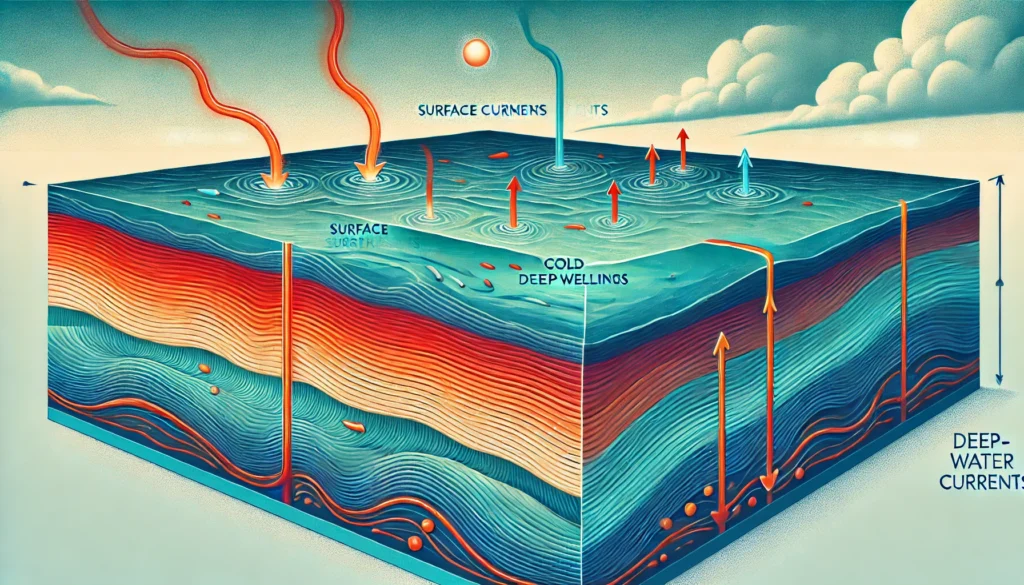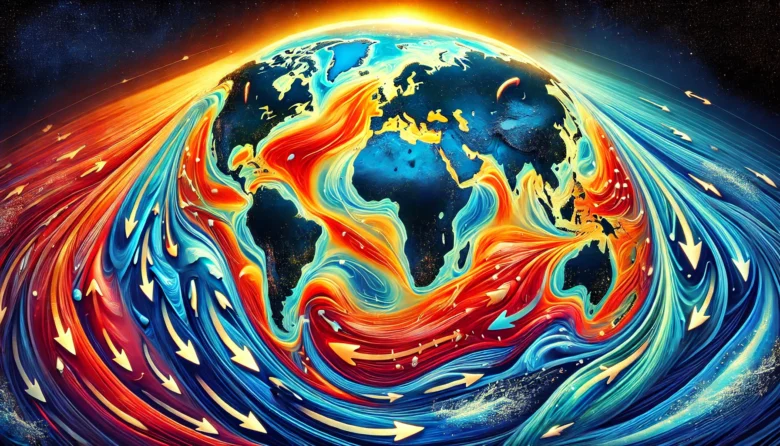The oceans are not merely large expanses of water; they are complex systems that influence the Earth’s climate, ecosystems, and economic structures. At the heart of these systems are ocean currents—powerful flows of water that move across the globe, influencing everything from weather patterns to marine life migration. In this blog, we’ll dive into the fascinating science of ocean currents and explore how these hidden forces impact our world in big and small ways.
What Are Ocean Currents?
Ocean currents are continuous, directed movements of seawater generated by various forces, including wind, the rotation of the Earth (Coriolis effect), temperature differences, and salinity variations. Ocean currents are classified into two main categories: surface currents and deep-water currents.
Surface currents, which are primarily driven by wind, are found in the upper 400 meters of the ocean.
Deep-water currents (or thermohaline currents) are driven by differences in water density, influenced by temperature (thermo) and salt content (haline).
Together, these currents create a global conveyor belt known as the “Thermohaline Circulation,” which plays a key role in regulating the Earth’s climate.

How Ocean Currents Work: The Science Behind the Flow
Ocean currents are influenced by several natural forces. Let’s break down the most important factors:
Wind: Surface currents are mainly driven by wind. The trade winds, westerlies, and polar easterlies help create patterns that guide ocean currents, like the Gulf Stream in the Atlantic Ocean.
Earth’s Rotation (Coriolis Effect): As a result of the Earth’s rotation, fluids such as air and water are deflected to the right in the Northern Hemisphere and to the left in the Southern Hemisphere. This deflection helps shape the paths of major ocean currents.
Temperature and Salinity: Warm water rises, and cold water sinks. Similarly, salty water is denser and sinks, while fresher water rises. These variations lead to vertical currents, driving deep ocean flows.
Gravity: When water piles up in one area due to wind or pressure changes, gravity pulls it down, creating currents.
Continental Landmasses: Landmasses like continents and islands act as barriers, redirecting currents along their coastlines, such as the Kuroshio Current near Japan.
The Global Conveyor Belt: A Key Player in Climate Regulation
One of the most fascinating aspects of ocean currents is the global conveyor belt, also known as the Thermohaline Circulation. This circulation of deep ocean waters plays a crucial role in regulating the Earth’s climate by transferring heat from the equatorial regions to the poles. As warm surface water flows toward the poles, it cools and sinks, creating a cycle of upwelling and downwelling that drives global water movement.
A well-known example is the Gulf Stream, a powerful surface current that moves warm water from the Gulf of Mexico toward Europe, helping to moderate the climate of Western Europe. Without it, places like the United Kingdom and Norway would be much colder.
Impact on Climate: The Role of Currents in Weather Patterns
Beyond affecting local temperatures, ocean currents are integral to shaping global climate patterns. A well-known example is the El Niño and La Niña phenomena, caused by changes in the ocean’s surface temperature in the Pacific Ocean.
El Niño occurs when warm water accumulates in the central and eastern Pacific, disrupting normal weather patterns and causing extreme weather, such as droughts in Australia and heavy rainfall in South America.
La Niña, on the other hand, is characterized by cooler-than-average ocean temperatures in the same region, leading to opposite weather patterns.
These cyclical changes can impact agriculture, fishing, and even economies.
Ocean Currents and Marine Ecosystems
Ocean currents are essential for marine ecosystems as they carry nutrients and oxygen around the globe, which are vital for the survival of aquatic life. Upwelling zones, where deep, nutrient-rich waters rise to the surface, are hotspots for biodiversity. The Humboldt Current off the coast of South America is a prime example. This nutrient-rich current supports one of the world’s largest fisheries, providing food for countless marine species and millions of people.
Additionally, ocean currents guide species’ migration patterns, such as sea turtles, whales, and fish. For example, the Pacific Ocean’s North Equatorial Current helps guide young sea turtles from nesting grounds to feeding areas, ensuring their survival.
Economic Impact: Shipping and Fishing Industries
Beyond their environmental importance, ocean currents have a significant economic impact, particularly on shipping and fishing industries. Shipping companies use currents like the Gulf Stream to save fuel and reduce travel time. The Gulf Stream, moving up to 6.4 km/h, can shave hours off a transatlantic journey.
Meanwhile, the fishing industry relies heavily on currents to sustain fish populations. Coastal upwelling zones, driven by ocean currents, provide nutrient-rich waters that attract fish, making them prime areas for commercial fisheries. This is why many of the world’s most productive fishing grounds, like those off the coasts of Chile and Peru, are found in these regions.
Climate Change and Its Effect on Ocean Currents
As global temperatures rise, ocean currents are at risk of disruption, which could have serious consequences for the planet. Changes in temperature and salinity due to melting ice and increased rainfall can slow down or even stop the global conveyor belt. This would have a domino effect on the global climate, making some regions colder and others hotter and disrupting marine ecosystems that rely on these currents for nutrient distribution.
Experts are increasingly concerned about the potential slowing of the Atlantic Meridional Overturning Circulation (AMOC), a critical part of the global conveyor belt system. A significant slowdown of this current could result in more extreme weather events, such as stronger hurricanes and higher sea levels along the U.S. East Coast.
Conclusion
Ocean currents are the lifeblood of our planet’s climate system, marine ecosystems, and global economies. From driving weather patterns to sustaining marine biodiversity, these hidden forces shape our world in ways we often take for granted. Understanding the science behind ocean currents and their global impact helps us appreciate their complexity and highlights the urgent need to protect our oceans, especially as climate change continues to pose new challenges.
As we continue to explore the mysteries of the deep, it becomes clear that our oceans’ health and climate stability are intricately linked. We must ensure that the balance of these vital systems remains intact for future generations.
Author’s Note
As someone who’s always been captivated by the ocean and its mysteries, researching ocean currents revealed how integral they are to life on Earth. I hope this blog inspires you to look beyond the surface and appreciate the invisible forces that make our planet dynamic and interconnected.
G.C., Ecosociosphere contributor.




